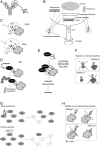Immunosympathectomy as the first phenotypic knockout with antibodies
- PMID: 23515328
- PMCID: PMC3612685
- DOI: 10.1073/pnas.1217586110
Immunosympathectomy as the first phenotypic knockout with antibodies
Abstract
In a PNAS Classic Article published in 1960, Rita Levi-Montalcini offered formal and conclusive proof that endogenous NGF was responsible for the survival of sympathetic neurons in vivo. Thus ended an experimental tour de force lasting a decade, starting with the demonstration that a humoral factor, produced from a tumor transplanted in a chicken embryo, was responsible for stimulating outgrowth of nerve fibers from sympathetic and sensory neurons. From a more general methodological point of view, this work provided a breakthrough in the quest to achieve targeted loss of function and experimentally validate the function of biological molecules. Finally, this work provided an example of the ablation of a specific neuronal subpopulation in an otherwise intact nervous system, an immunological knife of unsurpassed effectiveness and precision. The novelty and the importance of the PNAS Classic Article is discussed here, collocating it within the context of the particular moment of the NGF discovery saga, of Rita Levi-Montalcini's scientific and academic career, and of the general scientific context of those years. This seminal work, involving the use of antibodies for phenotypic knockout in vivo, planted seeds that were to bear new fruit many years later with the advent of monoclonal antibodies and recombinant antibody technologies.
Conflict of interest statement
The author declares no conflict of interest.
Figures


Comment on
-
DESTRUCTION OF THE SYMPATHETIC GANGLIA IN MAMMALS BY AN ANTISERUM TO A NERVE-GROWTH PROTEIN.Proc Natl Acad Sci U S A. 1960 Mar;46(3):384-91. doi: 10.1073/pnas.46.3.384. Proc Natl Acad Sci U S A. 1960. PMID: 16578497 Free PMC article. No abstract available.
References
-
- Levi-Montalcini R. Cantico di Una Vita. Milano: Raffaello Cortina; 2000.
Publication types
LinkOut - more resources
Full Text Sources
Other Literature Sources

